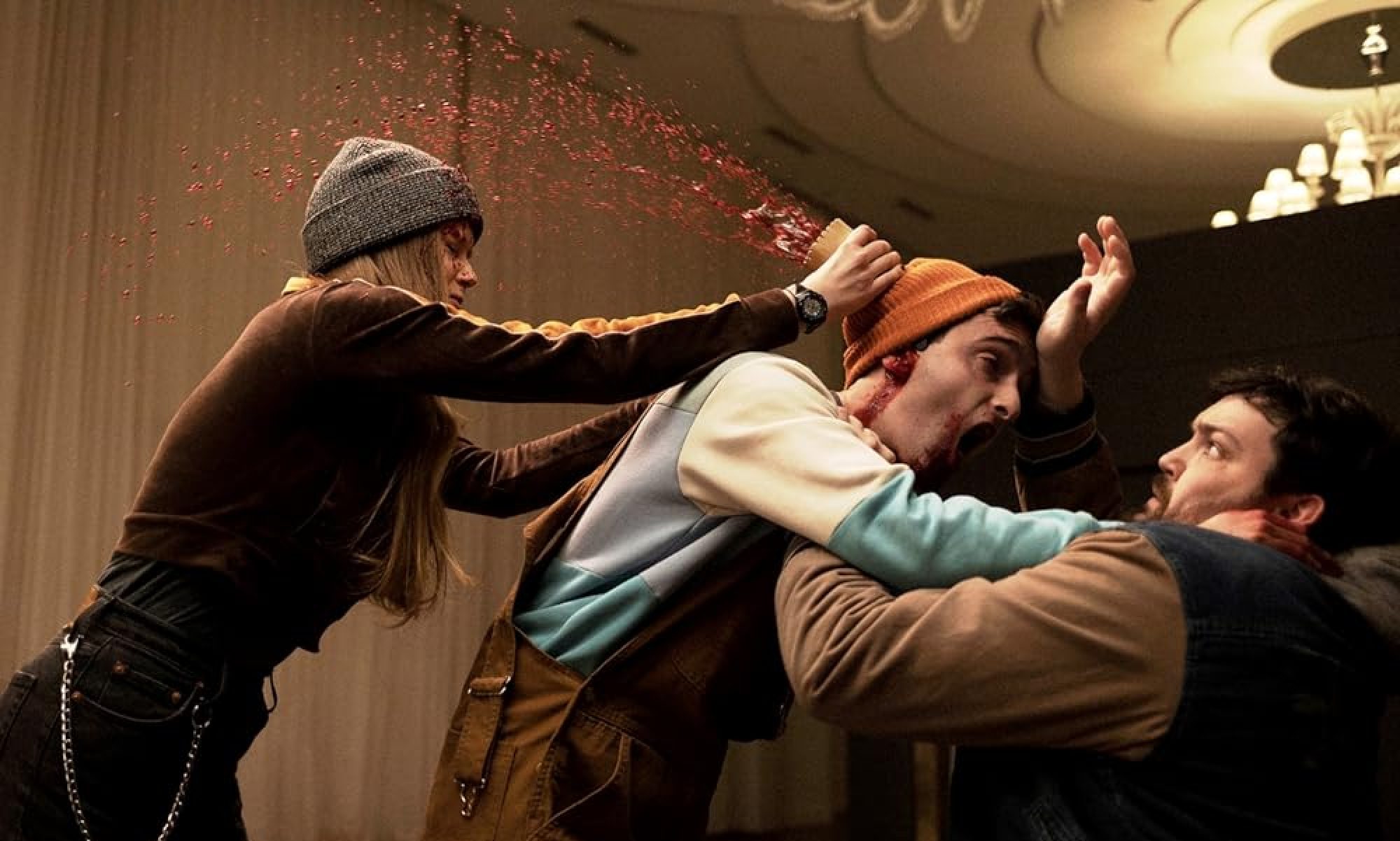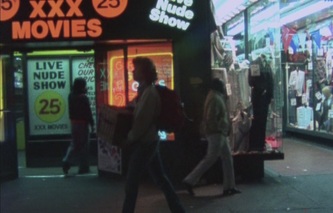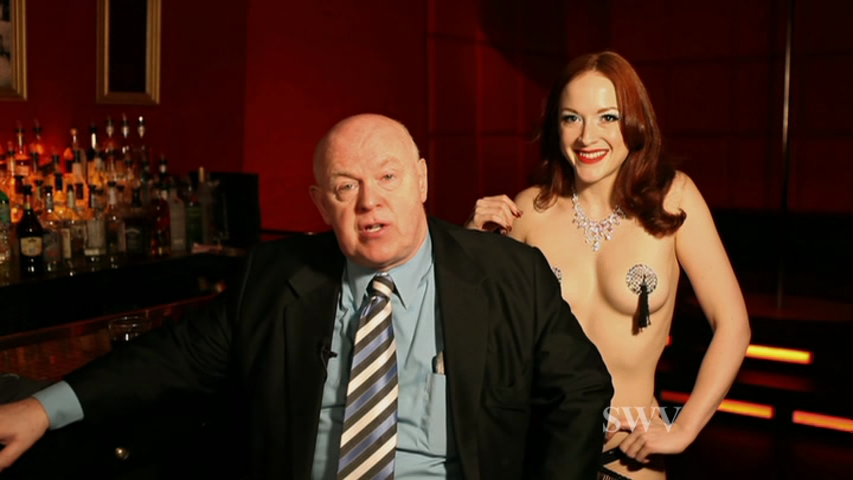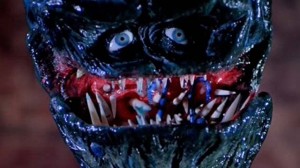One of the Guests of Honour at Horrorthon 2015 was Richard Stanley, director of Hardware and Dust Devil and subject of the recent documentary Lost Souls about the tortured production of The Island of Dr. Moreau from which he was fired as director. Horrorthon’s Fiona Foskin sat down with him during the festival for a most enlightening conversation.
Horrorthon: We’re interested in your creative process, you have produced some very interesting work over they years, how do you ‘work’ ?
Richard Stanley: The worst thing about ideas is I have to write them. I’m not a writer by trade, I’m a film maker by trade, but I’ve learned that if you want to control the underlying rights you have to be a writer. If you get a project that is brilliant and everyone wants it they will break your fingers to get it away from you they will not let you keep it; I found that out on Dr. Moreau. Once you’ve got an idea that is worth 75 million dollars people will do anything to take it. I realised then that I had to write the idea from the top to be inseparable from it. Which forces me to be a writer. if there is a pre-existing script there is always a legal possibility that someone can take that project away from you.
Writing is a painful and annoying process. Films are back-loaded with money, not front-loaded so there’s never any money upfront so the writer always get paid terribly and post-production people get paid disproportionately well, e.g. animators, press production people, there’s lots of money at the end of the movie but in the beginning there’s never any so it’s a painful and lonely process, writing always is, it’s a little bit shameful. It feels somehow like masturbation or like extruding piles because you have to go into a room on your own. Generally I find the best creative time for writing is early on. I try to identify some music which evokes the theme of the movie to me. It’s good to find some music which doesn’t have any other associations except for the thing you’re writing, so don’t use theme music. For the Island of Dr. Moreau I always put on the Forest of the Amazon by Villa Lobos the Brazilian composer. Every time I hear that I think immediately of the island, I think of the Beast Folk and they all come back into my head. The music is essential because when you are interrupted you have to get back into the zone, get back into the flow. It can take days or hours to find the zone. There comes a time when you’re close to it when you can feel it running through you when you can’t get it down fast enough, when the characters find voices of their own and they start talking to each other, that’s when it starts moving. To get to that point is quite hard. Once it reaches that stage the characters will stay alive no matter what happens. I have numerous dead projects that never got made. I’m still haunted by those fictional characters, I still feel a great allegiance to my Beast People from Dr. Moreau, even though almost none of them made it into the movie, but I know them well, Azazello, etc. they’re all in my head even though they’re not in the movie. I know how they, the characters speak, I know what they want, but I haven’t been able to express them. Sometimes once the movies made, it’s over. Most of the characters from Dust Devil have shut up and stopped bothering me.
H: So would unmade projects be stuck in your head, would there be things that you feel that you have to do?
RS: Yes, usually the ones that get made are the ones that have to get made and they keep coming back, the dream that always returns, the thing that year after year still remains fresh and still wants to be expressed in some way and those are ususally the ones that survive; more lightweight ideas evaporate over the course of time, so they aren’t worth the trouble. The ones that want to be born are like the Golem, the Jewish idea of an unborn thing which needs to be manifest and drawn down to be brought into being. These ideas that cluster around your shoulders and start to advise you, they want their expression. Of course once you’ve made the damn thing it goes out into the world and makes it’s own friends and before you know it you have fan-fiction and people are producing their own stories about the same characters, they get out there. The characters from Hardware survived and they made their own friends on the far side of the world in places like Japan, you’ll find 20 years later people wearing t-shirts with your characters on it.
H: To talk more about writing , you obviously have a very strong vision, how do you find working collaboratively on a film project? What for you are the ups and downs of the collaborative process?
RS: Well film making is a collaborative process and it has to be because no one human being can make a movie on their own; part of the glory of film making is that it’s an expression of so many art forms all in one pot, it should be the greatest medium of expression we have because it brings together writing, art, acting, photography, music, costume design and makeup artistry, so many great mediums of artistic expression and plainly if we were smarter and were able to actually not be totally dependent on money the way that we are now, then the medium has the potential to be the greatest art form available to man. Obviously no one individual can do all those things. When you’re making a movie you try to find the best people, get the best team together, if you can harmoniously bring that together and then bring the final product into light, when you take all that stuff and turn it into something ephemeral. Once you’ve caught the light and you torture it and duplicate it again and again until it’s just a piece of captured light and tortured time which is then sold and resold, well it’s a funny old thing when you’ve actually created that bit of light. It’s an extraordinary medium and I’m still in love with it. Film has been horribly abused in the 21st century because America has convinced us all that film is entertainment, which isn’t quite true, if we believed that art and writing was entertainment then we would have nothing to read besides Mills & Boon and Barbara Cartland. Obviously films has the potential to communicate powerful messages and not just entertain. Right now we are buying into a paradigm where all movies have three acts and we all have to make the audience feel that they have been suitable entertained, rather than traumatised or enlightened. Whereas in the 70’s we still had Ingmar Bergman and Andrei Tarkovsky trying to either enlighten the audience or brutalise them, bringing us to a point where we would see life in a different way. I don’t think modern audiences could deal with Goddard or Truffaut in the same way which is a shame. It won’t always be that way, things will change in another twenty years or so.
H: Could you talk us through the work you have showing at Horrorthon this year, Dust Devil, Hardware and a collection of shorts.
RS: Well, Dust Devil, which is playing in a few hours, is a very difficult movie, one of the most difficult I’ve ever made. It’s a Namibian movie. I made it for Namibia and the people of South Africa, who are a missionary culture. They were ruled by the Dutch Reform Church and they hated the Devil. In South Africa when I was growing up The Exorcist was banned, any reference to the Devil was cut out of culture under the Apartheid regime, when the Hammer Horror movie ‘Frankenstein and the Monster from Hell‘ played in South Africa the censor went over the prints with a felt tip pen and cut out all reference to Hell, so the movie read ‘Frankenstein and the Monster and *blip*’. This censoring gave me the idea that I wanted to make a South African Devil movie,which was targeted at the people who refused to speak about the Devil in such an extreme way. ‘Dust Devil’ came out of that. It was also the easiest idea for a movie I could think of at the time, I thought whats the simplest and cheapest thing we could shoot. It was a story with a girl driving across the desert and she picks up the Devil. It’s just two actors and the car for the whole movie, the landscape felt like the simplest and the cheapest movie I could possibly write or come up with. It took a while to get made, it went through so many twists and turns.
The Shorts, they don’t get a lot of airtme. Among the shorts is one of my documentaries, White Darkness which is a film about Voodoo and about the American occupation of Haiti, which I think is probably my best work. I think the middle of White Darkness is the material I’m most proud of, that I have shot. It’s got a very good middle, it manages to be political, supernatural and completely jarring because we’re seeing stuff which the audience will never expect. In this case it’s the brutality of the American regime, the Baptist Marines, you see the evident evil of the Christian characters who were trying to forcibly convert the Voodooists to their Christian religion which is not something we expect to see when we get into the movie. As the movie goes on the treatment of the Voodooists gets worse and worse, very disturbing, we also managed to get the head of the Marines deposed, Colonel Walter Walker Junior , he was removed from power as a result of this documentary. You can see that they are so obviously out of fucking order, you can see that they clearly believe that you have to have a Christian consensus in a nation before you can have a democracy. His version of democracy is based on Christianity, he believes they have to crush the Voodooists before they can have a democracy. It also shows the Crusader mentality, weirdly enough the Conservative Baptists Missionaries use the Georges Cross as their symbol, they actually have it on their uniform. Most of the Marines you see in White Darkness were sent to Afghanistan afterwards, they are all very clear thst they’re Crusaders. The Taliban and ISIS aren’t wrong when they say that the Marines are Crusaders, it really was the Crusades through a filter.
The other shorts are all things that I shot because I was bored or on a dare. The Children of the Kingdom was shot because of a bet, whether I could shoot a short movie in one day in London for 99euros. So it’s a 99euro, one day in London, shot on the underground movie, but I wouldn’t have done it unless someone had bet me to do it. Sea of Perdition was a film about Martian Exploration, it’s set during the colonisation of Mars. It’s interesting because if it was made now you’d assume it was a rip off of the Ridley Scott movie The Martian, but I asked them to play it because it’s so soon after the discovery of water on Mars, which is a factor in The Sea of Perdition. We shot it in a Volcano in the Arctic, it was minus 7 above ground, below ground it was very hot. We found this warm water lake beneath the Arctic by going down a Volcanic vent in Mount Krafla, which I was doing because I was following some notes from the Nazis. In another film I spent much time tracking down all surviving members of the Ahnenerbe SS, the folklore department of the SS, which gathered information about folklore, witchcraft and mythology. They were purged in 1939 and most of them were killed by the Christian SS, who came to fear them. Goebbels was gathering material to incriminate Himmler and the SS, when they became an embarrassment, so they were gotten rid of. Their research was shoved into the mass grave of Nazi information, until we decided to start back engineering it in 1998. There was a huge amount of folkloric data and mythology there, which no one was reading because it was all tainted by Nazism. I started going to the different sites that they had been excavating.That’s how I found the underground lake, it’s also how I found out about Montsegur where I live now from reading that material. World War Two set back the occult lodges and the Pagan movement for decades, they were all on the wrong side. In the 1950’s & 60’s it almost died. There was a time when the European hidden tradition almost died. The Nazis had also banned all the secret societies, the Freemasons and the Rosicrucians. It wasn’t until the hippies, when people started doing acid and reading Aleister Crowley and busting out their Madame Blavatsky that things came back.
H: Besides your own work what would you recommend at Horrorthon 2015?
RS: Out of the bunch Scherzo Diabolico, directed by Adrian Bogliano who made Late Phases and Here comes the Devil, a couple of years ago. I know Adrian quite well, he’s a talented lad and he knows what he’s doing. Personally I can’t resist The Golden Voyage of Sinbad in the presence of Caroline Munro, it’s just one of my favourite movies of all time, I’ve adored it since I was around 10 years old, it’s totally inspired me, it still touches my hear. The Voyage of Sinbad & King Kong definitely opened up my mind to the possibilities of cinema.
H: We wondered what you thought of current movie monsters and animatronics, can you talk us through some of the best and worst examples you’ve seen.
RS: Recently we’ve been a bit challenged because of the existence of CG, thanks to the ability to have everything fixed in post live animatronics have suffered, people have abandoned stop motion animation entirely. There are almost no animators left who are capable of the level of work that we saw from Ray Harryhausen and Willis O’Brien in the old days, which is a huge shame because it occurs to me that with computer animation we could perfect the process. What was wrong with Harryhausen’s work is that it strobes because every single frame is in focus as it’s photographed frame by frame, with computer techniques now we could overcome that problem. No ones got the talent to build the maquettes and the armatures, or the patience, which is a shame. I still think that the best monster movie ever made is The Thing by John Carpenter, I haven’t been grabbed by a monster movie as strongly ever since . It’s for a bunch of reasons; the Thing keeps evolving and changing, you never get a sense of what it actually looks like, whereas in Alien, we eventually realised it was a humanoid guy, it became less terrifying. Alien with Sigourney Weaver was terrifying for me up until the moment when she blasts it into space and you see it’s rubber tail! The game we all play with movie monsters is that you have to show it, you can’t not show the monster, you do have to show the monster, how long you show it for and how long you can keep the audience afraid is the most difficult part.
H: Richard would you have any advice for aspiring film makers?
RS: Whatever you do just keep shooting and don’t wait for permission, if you wait for somebody else to let you shoot you’ll be waiting forever. People are always waiting on the money, waiting for someone to agree to something, that stops you from being a film maker. You have to just get your goddamn camera and shoot anyway, shoot anything, keep shooting!
H: What should we look out for from you in the future, are you taking on Lovecraft?
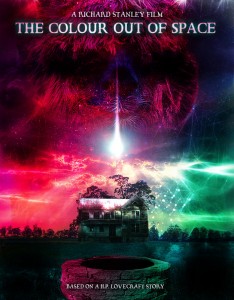 RS: I am, I adore Lovecraft, my mother introduced me to Lovecraft, she was a big fan, luckily for me. I got into Lovecraft when I was about 6 or 7, my gateway drug was Dreamquest for Unknown Kadath, a Lovecraft story for children, my mother read it to me when I was five or six, that provided the gateway. Lovecraft is very dear to me, and it occurred to me that there were not many decent movies on Lovecraft. The screen adaptations were often very poor and ususally played for laughs which is weird. The Last Call of Cthulhu and Whisper in the Darkness are sort of campy, pastiches. I liked Stewart Gordon, I played a fish monster in Dagon, I’m there with a bunch of other fish monsters in the sacrifice scenes which was fun, but it’s still a silly movie. I’ve always wanted to see what would happen if a Stanley Kubrick or an Ingmar Bergman or an Andrei Tarkovsky had taken him on. Lovecraft defined his theme as Cosmicism, cosmic terror, man’s frightful position in the cosmos, the fact that we’re surrounded by black seas od infinity, with no control over our destiny whatsoever. It’s a world that I don’t think anyone has ever been into, I don’t think any of the Lovecraft adaptations convey any of that. it seems to me that the main purpose of his work has been left offscreen, it hasn’t been tackled. It’s a theme that someone like Kubrick would really have made something out of too. Of course we’re not going to have a Kubrick style budget, but given what we have we’re going to try to do a serious Lovecraft adaptation, which doesn’t mean there’ll be no humour in it, human beings are still entitled to make jokes, but the human characters won’t have any chance of understanding what’s happening to them, the thing itself will be irrevocable, unfathomable and beyond anyone’s ability to deal with, unnameable and indescribable, as it should be. We’re doing The Colour out of Space, which technically can’t even be seen because it’s outside the spectrum, but it lives at the bottom of this family’s garden and exerts its malign influence on the family and their farm and the various characters struggle with that!
RS: I am, I adore Lovecraft, my mother introduced me to Lovecraft, she was a big fan, luckily for me. I got into Lovecraft when I was about 6 or 7, my gateway drug was Dreamquest for Unknown Kadath, a Lovecraft story for children, my mother read it to me when I was five or six, that provided the gateway. Lovecraft is very dear to me, and it occurred to me that there were not many decent movies on Lovecraft. The screen adaptations were often very poor and ususally played for laughs which is weird. The Last Call of Cthulhu and Whisper in the Darkness are sort of campy, pastiches. I liked Stewart Gordon, I played a fish monster in Dagon, I’m there with a bunch of other fish monsters in the sacrifice scenes which was fun, but it’s still a silly movie. I’ve always wanted to see what would happen if a Stanley Kubrick or an Ingmar Bergman or an Andrei Tarkovsky had taken him on. Lovecraft defined his theme as Cosmicism, cosmic terror, man’s frightful position in the cosmos, the fact that we’re surrounded by black seas od infinity, with no control over our destiny whatsoever. It’s a world that I don’t think anyone has ever been into, I don’t think any of the Lovecraft adaptations convey any of that. it seems to me that the main purpose of his work has been left offscreen, it hasn’t been tackled. It’s a theme that someone like Kubrick would really have made something out of too. Of course we’re not going to have a Kubrick style budget, but given what we have we’re going to try to do a serious Lovecraft adaptation, which doesn’t mean there’ll be no humour in it, human beings are still entitled to make jokes, but the human characters won’t have any chance of understanding what’s happening to them, the thing itself will be irrevocable, unfathomable and beyond anyone’s ability to deal with, unnameable and indescribable, as it should be. We’re doing The Colour out of Space, which technically can’t even be seen because it’s outside the spectrum, but it lives at the bottom of this family’s garden and exerts its malign influence on the family and their farm and the various characters struggle with that!
